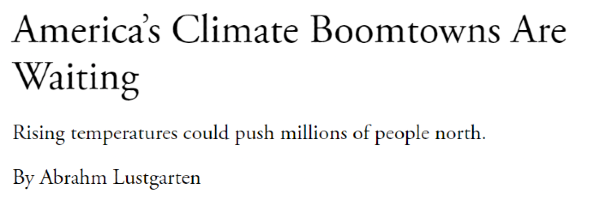

Revealing data debunks the widely held belief of climate-driven migration towards cooler U.S. regions with current demographic data showing a persistent trend of people moving to warmer southern states.
A climate narrative often presented by some media outlets suggest that climate-driven migration will lead to a mass exodus from the hotter southern and western regions of the United States to cooler areas, such as Detroit. However, an analysis by Tony Heller of demographic data and migration trends indicates a different reality.
Contrary to the narrative of climate-induced migration to cooler regions, recent demographic data reveals a significant movement of people from colder northern states to warmer southern states. States like Texas, Florida, North Carolina, Georgia, and South Carolina have seen substantial population growth. Collectively, these states added close to 1.2 million residents in the past year, with the South being the only region to net new residents from other parts of the country. This trend suggests that warmer climates remain a strong draw for many Americans.

Historical preferences for warmer climates are evident in the choices made by university students decades ago. For instance, Arizona State University attracted a significant number of students from the upper Midwest in the 1970s, largely due to its warm climate, even though the region experienced extreme heatwaves.
Forecasts by climate scientists, such as Jonathan Overpeck, suggest that cities like Phoenix could experience extreme temperatures, including regular days in the 130s by the latter half of the century. Concerns also extend to the viability of water sources like Lake Mead and Lake Powell. Despite these predictions, Maricopa County, encompassing Phoenix, remains the fastest-growing county in the U.S.

Phoenix's temperature records show that the last time it reached 120 degrees was in 1995, and historically, extremely high temperatures over 120 degrees for extended periods are rare occurrences.

Contrary to expectations of a desolate and excessively hot environment, Arizona still experiences significant snowfall. The ski area at Flagstaff received over 204 inches of snow, illustrating the state's diverse climate, which allows for warm weather and snow on the same day.

The reduction in stream flow in the Colorado River has been attributed to various factors, including biofuel mandates. These mandates have led to the diversion of water from the Colorado River drainage to support corn production for ethanol on Colorado's Front Range, impacting the river's flow.

The Atlantic's claim that wildfires in the western and southern U.S. are worsening due to fossil fuel consumption is contested by data showing that burn acreage has significantly decreased since the 1930s. The number of hot days in the U.S. has also declined since that time, suggesting a more complex relationship between climate factors and wildfire incidence.



The credibility of the press in reporting on climate issues is questioned in light of past predictions that have not come to fruition, such as the anticipated movement of "climate refugees" to Antarctica. Despite dire forecasts, Antarctica recently recorded its coldest six months, and the idea of a substantial human settlement there by 2040 appears unfounded.

The current demographic trends and historical climate data challenge the narrative of a climate-driven migration to cooler regions in the United States. People continue to move to warmer areas like Phoenix, suggesting a preference for these climates over cooler ones.